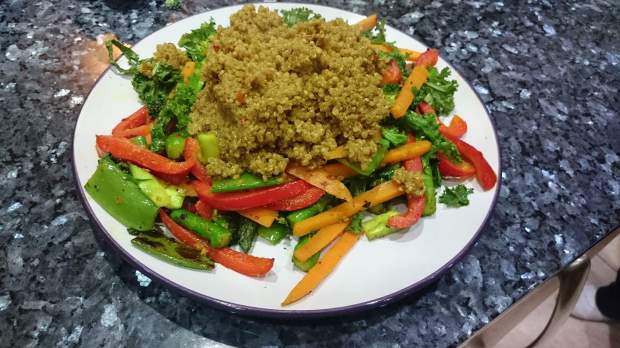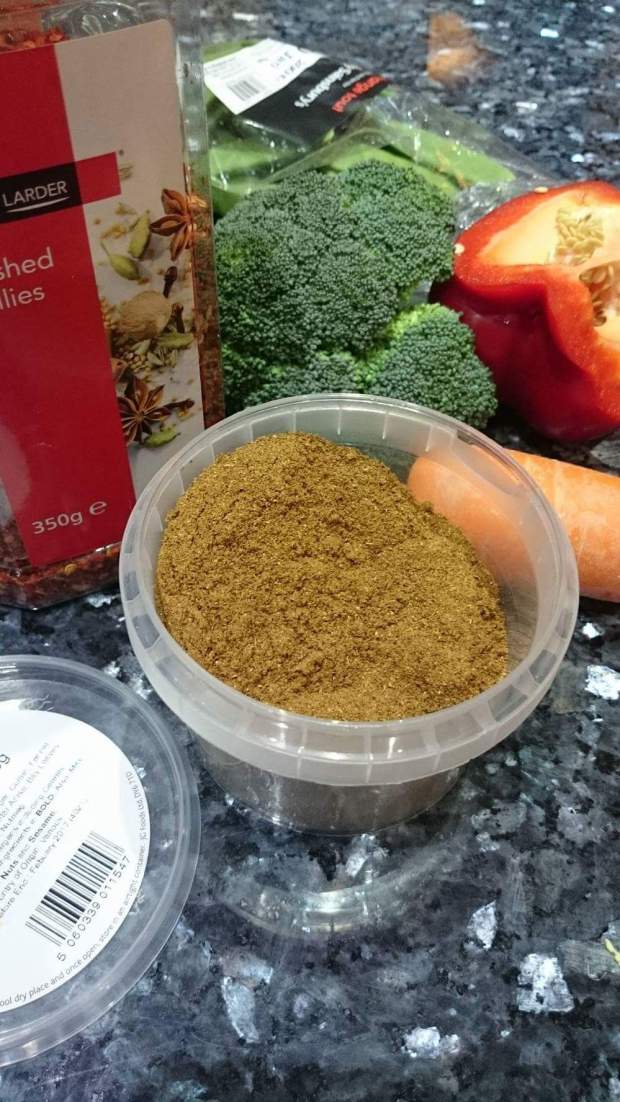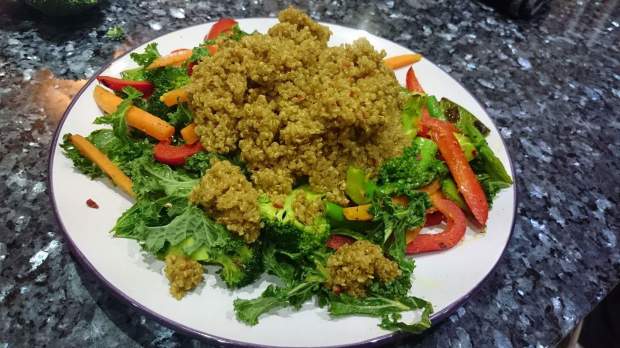So, Gyoza are something we have a wagamamas on occasions and, although we love them, they are pretty expensive for what you’re getting. It isn’t something I had ever thought about trying to make before but I had a craving and decided to look up some recipes for inspiration.
As I’m sensitive to gluten, it made sense that I should make a gluten free gyoza dough. After looking at many recipes I found this one here, it looked pretty straight forward so i was just going to make it, until i realised I didnt have any millet flour. So I did some research and found that I should be able to use quinoa flour instead of the millet.. Seeing as this is a new thing to me, I thought ‘Hey, lets wing it and see’. So the dough I have made is not my own, just an adaptation of this one.
Now, with the filling, I really wanted something simple with just vegetables and most of the recipes I found contained either meat, tofu or some exotic ingredients that I havent heard of! So instead of following a recipe I adapted this one and made it with simple ingredients you’re likely to have in the cupboard!
Making the gyozas was a pretty long winded process but it was an easy one and definitely worth the time! They were absolutely delicious and tasted fantastic dunked in the dipping sauce from this recipe.

For most of the filling recipes I looked at they called for many different types of cabbage, mostly wombok but alas, this is not readily available when I live so instead of going out to hunt for a replacement I noticed we had a large stockpile of sprouts which are basically baby cabbages. Thankfully, they worked perfectly and tasted fantastic. Not only that but they were super easy to shred finely. So yeah, you can play around with sprouts or whatever cabbages you can get your hands on! Go wild!

I started by making the filling, so that it had time to chill before it was time to use it. If you have the means to chill the filling whilst the dough is resting, then make it after you’ve made the dough! It will work either way.
Ingredients for the filling
- 100g mushrooms finely chopped (I used chestnut)
- 2 spring onions thinly sliced
- 2 large cloves of garlic, crushed
- 1 cup of finely shredded cabbage (I used sprouts)
- 1 packed tbsp grated ginger
- 1 carrot, grated
- 1 tbsp soy sauce
- 1/2 tbsp rice vinegar
- 1 tsp sesame oil
Heat the oil in a frying pan and add the mushrooms, onion, garlic, cabbage, carrot and ginger. Fry for around 6 minutes till the cabbage has wilted and the carrots have softened. Stir in the soy sauce and rice vinegar. Take the pan off of the heat and transfer the mix to a bowl to cool. Place to one side until you are ready to use it.
Ingredients for the dough
- 95g tapioca starch
- 95g quinoa flour
- 122g glutinous (sweet) rice flour + more for dusting
- 2tsp xanthan gum
- 3/4 cup of just boiled water
- 1-2tsp cold water
- 2 cups of dumpling filling
Mix together the tapioca starch, quinoa flour, sweet rice flour and the xanthan gum in a bowl. Pour in the just boiled water and stir together to create a crumbly mixture. Now, using your hands, knead in 1-2 tbsp of cold water to bring the mixture into a smooth ball of dough. Place the ball of dough into a plastic bag, prefereably zip-top, squeeze the air out then close. Let the dough sit in the bag for between 15 minutes and 2 hours.
To form the dumplings: Lightly flour the work surface with sweet rice flour. It is easier to work with just a quarter of the dough at a time, this prevents the dough drying out, so keep the dough in the bag till ready to use. Take portion of dough and roll it into a sausage shape that is around 1 inch thick. Cut this into 8 equal protions. Coat the ends of each piece with rice flour. Using your hands, press each piece into a little disk and place onto your floured surface. Roll the disk into roughly a 3 inch round using a rolling pin. Fill the wrapper with 1-2 tsp of filling, wet the edge of the wrapper with a small dab of water and close. Push the edges together into a half moon shape, stand it up, then to esure it stays shut, pinch the edges (see pictures below). There are fancier shapes you can make once you get confident, but this is a good place to start. Repeat with all of the portions of dough and place each gyoza onto a lightly floured baking tray. These are best cooked shortly after making them, but i did find they could be stored in a sealed container and cooked the next day. Apparently they can also be frozen but I havent tried myself, so if you do, let me know.
To cook: Pan fry the dumplings in batches of as many that will cover the bottom of a frying pan. Be sure to use a non-stick pan with a lid. Put enough oil in the pan to lightly cover the bottom. Turn it up to a medium-high heat and place the dumplings in, no need to leave to much space between them, just don’t let the dumplings touch or they may stick together. Brown the bottom of the dumplings, then pour in between 1/4 to 1/3 of a cup of water (depending on size of pan). Cover the pan, turn the heat to low and let all of the water bubble away. Once there is only a dribble of water left in the pan, tilt the lid to let the steam out and continue to cook. When the water is all gone remove the lid completely and turn the heat up slightly. Fry again till the bottoms are crisp then remove them from the pan with tongs. Serve with your dipping sauce of your choice!
My recommended sauce is here.
These photos below are how I closed up my dumplings.
A little tip: I always buy fresh ginger roots and stick them in the freezer! This way, it doesn’t go off and is super easy to grate, plus, if you need sliced ginger, just get the ginger out of the freezer to thaw in advance and it defrosts super easily! Also, i rarely peel my ginger if i’m grating it, you won’t even notice the skin in there.







































